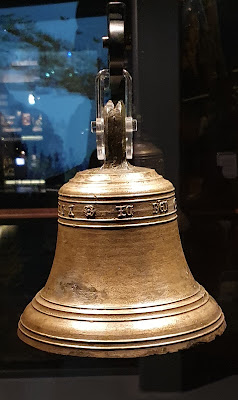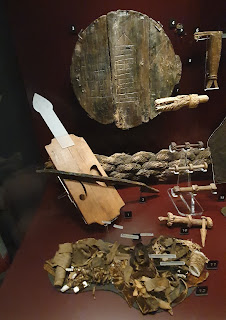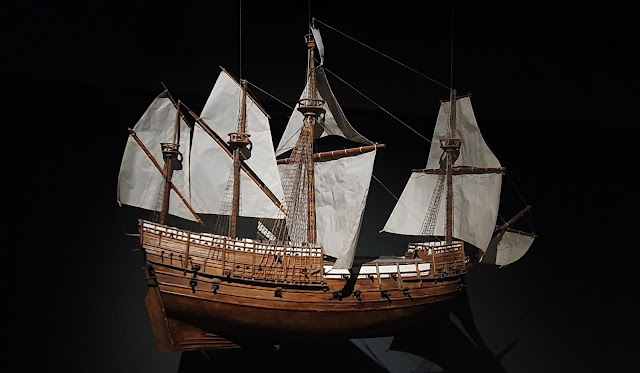Wednesday, 24 May 2023
Museum of London Docklands by Jeannie Waudby
Writing Challenge
The Museum of London Docklands shows what happened when some people’s freedom – a right that every human being should have – was stolen from them. Can you write an acrostic poem for the word ‘FREEDOM’? Or if you love drawing, you could write the word with a beautifully designed first letter. Long ago, when books had to be written by hand, scribes highlighted the importance of their words by taking the first letter, making it larger and illustrating, or ‘illuminating’ it.You can link to the video here
Some other museums covering the history of Britain’s involvement in the slave trade:
International Slavery Museum, Liverpool
The British Empire and Commonwealth Museum, Bristol
Bristol City’s Museums, Galleries and Archives
Hull City Museums and Art Gallery
The National Maritime Museum, GreenwichJeannie Waudby is the author of YA thriller/love story One of Us. She has recently completed a YA novel set in Victorian times.
Wednesday, 17 May 2023
Writing Historical Heists with Laura Noakes
A heist story follows the
planning, completion and aftermath of a theft of an item or items from a place.
It often involves a group of heisters, who each have a specific skillset that
will help them to pull off the caper.
When I sat down to write my heist, I was inspired a lot by the films I watched as a kid. I think my introduction to heists was the classic film The Italian Job, which stars Michael Caine and is set in Italy in the 1960s. I was blown away by the clever ways the characters sought to outwit the security measures to get their hands on some valuable gold, as well as the literal cliffhanger ending! I fell in love with heists watching the Oceans Eleven series, which is far more modern. I loved the cool gadgets and tech the gang used as they closed in on the vault.
So quite a lot of my ‘research’ into the different types of heists was actually just rewatching a lot of my favourite heist films, which was a lot of fun! From these rewatches, I noticed that there are a few elements common in many heists, and I turned these elements into questions to help plot my heist story:
1) Who
is the mastermind behind the heist?
2) Who
makes up the heist team?
3) What
are the team trying to steal?
4) Why
are they trying to steal it?
5) What’s
the plan?
6) What’s the twist?
Having answers to these questions meant that whenever I got writer’s block, I was able to unstick myself pretty quickly.
As I wrote my own heist, which is set in 1899 in London, I had to be really aware of the time period and how the historical setting would impact on my heist. In 1899, Queen Victoria was on the throne, women didn’t have the vote and much of the technology we take for granted today didn’t exist yet! I really wanted readers to feel as though they were in late-Victorian London, so I did a lot of research on what living during that time would have been like.
This research came in many forms. I read a lot of non-fiction books about the Victorian era and Victorian London—one my favourites is How to be a Victorian by Ruth Goodman, which told me a lot about everyday life. I also read fiction books set during the Victorian era, and books written by Victorians, like Oliver Twist by Charles Dickens.
Websites were also a huge research tool. My main character, Cosima, lives in a group home for disabled children run by a matron. These homes really did exist during the Victorian era, and thinking about these institutions served as the spark which inspired my story. A brilliant website created by Peter Higginbotham formed the core component of my research into these homes: http://www.childrenshomes.org.uk/. Peter is also the author of several excellent books which I wholeheartedly recommend.
I have the same disability as Cos—Hypermobility Spectrum Disorder—so I thought a lot about how different my life would have been if I’d have been brought up in a Home and being disabled during the Victorian era. There isn’t a tonne of information on how disabled people lived in the past, so I turned to a thoroughly modern research tool: the internet!
Finally, I also watched a lot of films and TV shows set in the Victorian era and I also watched many historical documentaries. One of my favourite movies that I saw during research was Enola Holmes, starring Millie Bobby Brown.
When it came to the heist itself, setting my story in the past actually helped in some respects. In 1899, there are no motion detectors, CCTV cameras or complicated security systems to bypass. However, this doesn’t mean that pulling off a heist was easy—Victorians were just as security conscious as we are! Cos and her friends still have to navigate guards, seemingly impenetrable walls, and complicated safes to reach the jewels they’re after.
Heists are full of twists and turns that readers don’t see coming, and I hope I’ve managed to sneak a few into my story. Creating an unexpected twist was really difficult—and I think what helped me to make my twist surprising was that I was also surprised by it.
Bringing the two components of my story together, the historical and the heist, was probably my favourite part of writing my book!
Writing Challenge
I challenge you to plot a historical heist story. This story can be set in any historical period!
Think about how the era will impact on your heist. For example, if your story is set in the pre-historic era, its unlikely that cave-people would want steal a million pounds, because that form of currency didn’t exist then. Maybe instead your cave-people’s target is a Woolley Mammoth! If your heist happens during World War II, what impact will an unexpected air raid have on your characters?
Laura Noakes grew up in Bedfordshire in a home full of books. She loved books so much she went to three universities after school, and graduated with a PhD in Legal History in 2021. Writing stories is her first love. She has Hypermobility Spectrum Disorder, a disability that she shares with her main character, Cosima. Laura now lives in beautiful Cumbria with her husband, Connor, and their two mischievous cats, Scout & Sunny.
Laura's debut book, Cosima Unfortunate Steals a Star, will be published by Harper Collins on May 25th 2023. Buy a copy online at - https://www.bookscumbria.com/product/uk-books/signed-editions/cosima-unfortunate-steals-a-star/Learn more about Laura and her writing at her website and follow her on twitter, Facebook and Instagram
Thursday, 11 May 2023
#NationalTechnologyDay: Sir William Arrol
It's a fair hike from my home in the Highlands to the exhibition at Ayr's Rozelle House - to my great shame, I had only passed through the town so far, so I jumped at the chance to visit, courtesy of the Scottish Book Trust's Live Literature funding. I was picked up by Kirsty Menzies, the researcher behind the Arrol exhibition and part of Friends of Seafield House, William Arrol's residence currently undergoing ambitious refurbishment. With a personal family connection to the Arrols, she is a fountain of knowledge and was the ideal companion for my visit. My workshops were fun, and I loved reading some of the Arrol sections from Rivet Boy in the place where he had lived. However, most memorable of all was the time spent browsing the handful of rooms devoted to the great Victorian engineer. Not only did he build iconic landmarks like the Forth Bridge, the replacement Tay Bridge (following the Tay Bridge disaster), Tower Bridge in London and even a bridge across the River Nile in Cairo. No, he also invented tools and practices to make metal work more efficient, such as the hydraulic riveting machine. In addition, his company built gantries, cranes and workshops, including the one on which the Titanic and her sister ship the Olympia were built in Belfast.
Barbara with her book Rivet Boy, in front of the Arrol-built Forth Bridge. William Arrol is a character in the novel which is set during the Bridge's construction in 1888-1890 Buy the book here. Find out more about Barbara on her website.
Wednesday, 3 May 2023
The Mary Rose: Ship of Stories
In my Tudor-set adventure, The Queen’s Fool, my heroes, young orphan girl, Cat Sparrow and her new-found friend, French boy, Jacques Bonhomme find themselves voyaging across the English Channel to Calais as part of King Henry VIII’s entourage bound for the grand Anglo-French peace celebrations at the Field of Cloth of Gold in June 1520.
The sea
journey presented a brilliant opportunity to include an exciting chase scene with
the villain which results in poor Jacques falling overboard and which leads on
to a dramatic ‘reveal’ that hopefully young readers won’t see coming.
To write
these shipboard scenes meant that I needed to understand the layout and
construction of Tudor ships, how you might have boarded them – by small boats and
a set of ropes, ladders and nets as it turns out – and what life both above and
below deck was like for passengers and crew.
A key primary resource proved to be an ‘old friend’ – the wreck of King Henry’s favourite warship and flagship, The Mary Rose, which had been part of the king’s escort of ships that day on the journey across to France. I’m fortunate enough to live within an hour’s drive of Portsmouth Harbour where, over four centuries after her dramatic sinking at the end of Henry’s reign, the remains of The Mary Rose were discovered and, in 1982, brought to the surface in an event broadcast across the world.
A miraculous resurrection
In fact it was as a teenager that I paid my first ever visit to see what was left of The Mary Rose, not long after she first went on public display in the mid 1980s in a covered dry dock
at the Portsmouth Historic Dockyard – though at the time the surviving timbers of the wreck were heavily veiled in plastic and being sprayed with water to keep them from drying out. I returned several times over the years as they were further treated with preserving chemicals and then, finally, air-dried.But the wreck
of The Mary Rose harbours other,
equally fascinating stories. These include the part the ship played in the
history of the early English navy, how she came to sink on that fateful day
back in 1545 and the lives – and deaths – of the men who formed her crew.
Pride of a king
For 34 years after her construction and launch in Portsmouth in 1511, The Mary Rose was the pride of King Henry VIII’s navy. A 600 ton carrack and one of the earliest known examples of a purpose-built sailing warship, she was reputedly built to the young king’s own design. She saw a number of actions over the years in battles and skirmishes against the French navy and in the defence against King James IV of Scotland’s attempted invasion of England. And records also show that she underwent a substantial refit during the 1530s with the addition of a number of extra, heavy guns.
Her final
action took place on 19th July 1545, when she was part of an English
fleet of 80 vessels involved in a face-off against over 200 ships of the French
navy gathered in the Solent – the stretch of water between Portsmouth Harbour and
the Isle of Wight. The French were on a mission of revenge for Henry VIII’s capture
of the French town of Boulogne the previous year, and Henry himself came down
to watch the action from nearby Southsea Castle.
But what actually caused The Mary Rose to sink? A surviving eye-witness reported that, seeking to engage the enemy, she fired first from her starboard side, then turned about to fire from her port side. But as she made the turn, her sails were caught by a gust of wind and she was blown over. This resulted in her still-open starboard gun-ports taking on water as they dipped below the waterline.
Alternative theories emerged over time including that there had been too many guns and
soldiers on board, or that the earlier refit of the vessel had resulted in some
fundamental design flaws. There was even the suggestion that the officers or
crew might not have been up to the job. The French themselves maintained they
had holed the ship with a cannonball, though none of these claims has ever been
convincingly substantiated.
Whatever the
full story, it took no more than a handful of minutes for The Mary Rose to disappear beneath the waves with the loss of
almost the entire crew. Estimates vary but it is believed over 450 men drowned that day with around only 35 survivors.
A porthole into the past
For me the
most intriguing stories are to be found in the huge haul of archaeological
treasures painstakingly excavated from the mud of the seabed. These represent a
sort of Tudor time-capsule, illuminating both the operation of a ship of Henry
VIII’s navy and the day-to-day lives of the mariners, soldiers, gunners and
servants on board. Stand-out items include the ship’s bell; the cannon bearing
the King’s personal Tudor rose symbol; the chests of Yew longbows and thousands
of arrows for use by the archers in battle; the two great brick ovens and cauldrons
and the eating utensils used to serve the crew their food, not forgetting the detachable
mast-top which crowned the ship’s main mast.
Other highlights
are the more personal items belonging to individual crew members, all of them male, most young adults and some just boys. These range
from leather shoes, jerkins and hats to dice, gaming boards and musical
instruments including something called a shawm – an early type of oboe. Also writing
materials including ink pots, quill pens and even leather book covers, though
the pages have long since rotted away.
And then there are tools of the trade belonging to men of the ship’s company such as the carpenter – including his mallet, planes and rulers – and the surgeon, whose belongings – his canisters of ointments, metal syringes and a bowl to collect the patient’s blood during blood-letting – I found particularly intriguing because of a crucial scene I set in the surgeon’s cabin on board ship in The Queen’s Fool.
Finally,
there are the remains – human and animal – which tell their own tales. For
example the bones of men believed to have been archers, which show the stress
caused to arm and shoulder muscles and joints by the regular shooting of many
arrows. And the isotope analysis of teeth which has allowed historians to
demonstrate that the crew were not only of English origin but that some of them
came from places as far afield as the Mediterranean and North Africa.
And perhaps my
favourite find of all – the skeleton of a small dog discovered outside the
carpenter’s cabin. Nicknamed Hatch by the
museum team and identified from his bones as a sort of terrier, similar to a
modern day Jack Russell, he is believed to have been the ship’s ratter. And as relatively
few rat bones were found in the wreck, the museum staff reckon he must have
been pretty good at his job!
Scarcely any
personal information is known about the individuals who went down with King
Henry VIII’s great flagship that day nearly 500 years ago. But through the
treasure-trove of objects rescued from the deep, we are part way at least to
bringing them and their stories back to life.
More information about the fascinating and inspirational artefacts and stories connected with The Mary Rose is available from the museum website here.
View Ally’s
video on The Mary Rose on YouTube
Kids here.
Ally Sherrick
is the award-winning author of stories full of history, mystery and adventure.
BLACK POWDER, her debut
novel about a boy caught up in the Gunpowder Plot, won the Historical Association’s Young Quills Award.
Other titles include THE BURIED CROWN,
a wartime tale with a whiff of Anglo-Saxon myth and magic and THE QUEEN’S FOOL, a story of treachery
and treason set at the court of King Henry VIII. Ally’s latest book, published in
February 2023 with Chicken House Books, is VITA
AND THE GLADIATOR, the story of a young girl’s fight for justice in the
high-stakes world of London’s gladiatorial arena.
Ally’s books
are available from bookshop.org.uk and all good high street bookshops
For more
information visit Ally's website. You can also follow her on Twitter
@ally_sherrick
VIKING ATTACK! Write a DUAL NARRATIVE ACTION SCENE
VIKING ATTACK! Write a DUAL NARRATIVE ACTION SCENE First, watch the Time Tunnellers video about the Viking Attack on the Holy Island of L...

-
VIKING ATTACK! Write a DUAL NARRATIVE ACTION SCENE First, watch the Time Tunnellers video about the Viking Attack on the Holy Island of L...
-
That the Paralympics rose out of such a dark place, from the ashes of the Second World War, wounded men and a fugitive from the Nazis, says ...
-
On Thursday July 4th, the U.K will go to the polls to vote in the General Election. Eligible voters will select from a list of candidates wh...
































